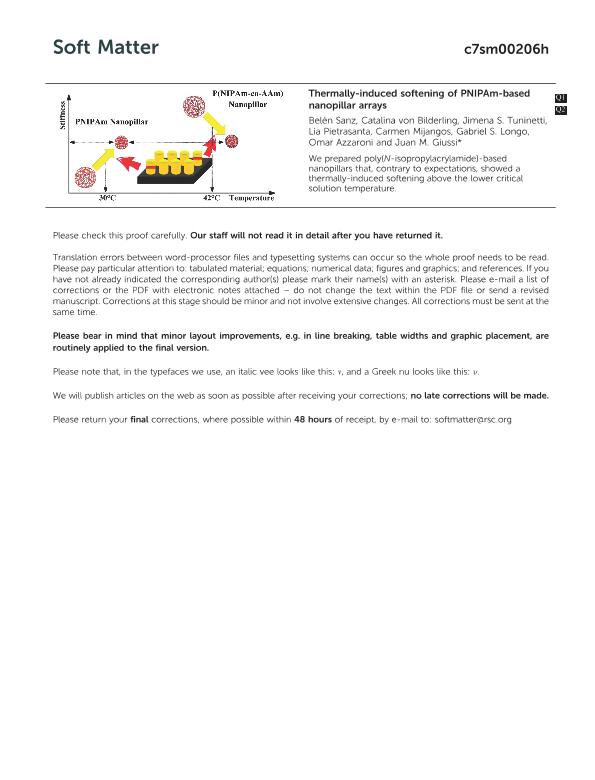Artículo
Thermally-induced softening of PNIPAm-based nanopillar arrays
Sanz, Belén; Von Bilderling, Catalina ; Tuninetti, Jimena Soledad
; Tuninetti, Jimena Soledad ; Pietrasanta, Lia
; Pietrasanta, Lia ; Mijangos Ugarte, Carmen; Longo, Gabriel Sebastian
; Mijangos Ugarte, Carmen; Longo, Gabriel Sebastian ; Azzaroni, Omar
; Azzaroni, Omar ; Giussi, Juan Martín
; Giussi, Juan Martín
 ; Tuninetti, Jimena Soledad
; Tuninetti, Jimena Soledad ; Pietrasanta, Lia
; Pietrasanta, Lia ; Mijangos Ugarte, Carmen; Longo, Gabriel Sebastian
; Mijangos Ugarte, Carmen; Longo, Gabriel Sebastian ; Azzaroni, Omar
; Azzaroni, Omar ; Giussi, Juan Martín
; Giussi, Juan Martín
Fecha de publicación:
03/2017
Editorial:
Royal Society of Chemistry
Revista:
Soft Matter
ISSN:
1744-683X
Idioma:
Inglés
Tipo de recurso:
Artículo publicado
Clasificación temática:
Resumen
The surface properties of soft nanostructured hydrogels are crucial in the design of responsive materials that can be used as platforms to create adaptive devices. The lower critical solution temperature (LCST) of thermo-responsive hydrogels such as poly(N-isopropylacrylamide) (PNIPAm) can be modified by introducing a hydrophilic monomer to create a wide range of thermo-responsive micro-/nano-structures in a large temperature range. Using surface initiation atom-transfer radical polymerization in synthesized anodized aluminum oxide templates, we designed, fabricated, and characterized thermo-responsive nanopillars based on PNIPAm hydrogels with tunable mechanical properties by incorporating acrylamide monomers (AAm). In addition to their LCST, the incorporation of a hydrophilic entity in the nanopillars based on PNIPAm has abruptly changed the topological and mechanical properties of our system. To gain an insight into the mechanical properties of the nanostructure, its hydrophilic/hydrophobic behavior and topological characteristics, atomic force microscopy, molecular dynamics simulations and water contact angle studies were combined. When changing the nanopillar composition, a significant and opposite variation was observed in their mechanical properties. As temperature increased above the LCST, the stiffness of PNIPAm nanopillars, as expected, did so too, in contrast to the stiffness of PNIPAm-AAm nanopillars that decreased significantly. The molecular dynamics simulations proposed a local molecular rearrangement in our nanosystems at the LCST. The local aggregation of NIPAm segments near the center of the nanopillars displaced the hydrophilic AAm units towards the surface of the structure leading to contact with the aqueous environment. This behavior was confirmed via contact angle measurements below and above the LCST.
Palabras clave:
Nanopillars
,
Pnipam
,
Mechanical And Wetting Properties
,
Surface Softening
Archivos asociados
Licencia
Identificadores
Colecciones
Articulos(IFIBA)
Articulos de INST.DE FISICA DE BUENOS AIRES
Articulos de INST.DE FISICA DE BUENOS AIRES
Citación
Sanz, Belén; Von Bilderling, Catalina; Tuninetti, Jimena Soledad; Pietrasanta, Lia; Mijangos Ugarte, Carmen; et al.; Thermally-induced softening of PNIPAm-based nanopillar arrays; Royal Society of Chemistry; Soft Matter; 13; 13; 3-2017; 2453-2464
Compartir
Altmétricas



